- 022 315 8987
- info@myhomesconstruct.co.nz
Gutters are an essential part of any Auckland home, protecting your property from the city’s frequent rainfall (1,200mm annually, per NIWA) and humid conditions. But when a gutter starts leaking, it can lead to costly damage, from foundation cracks to mold growth, especially in a city known for its wet winters and humid summers. So, how can you tell if your gutter is leaking before the problem escalates? Early detection is key to avoiding expensive repairs and keeping your home safe from water damage.
At My Homes Construct Ltd, we’ve been helping Auckland homeowners with gutter repairs for over 10 years, from West Harbour to Papakura. In this comprehensive guide, we’ll show you how to tell if your gutter is leaking, explain why early detection matters, and share practical steps to check for leaks. We’ll also cover Auckland-specific challenges, preventative maintenance tips, when a DIY fix might work, and when it’s time to call in professionals, ensuring your home stays protected in New Zealand’s unique climate. Whether you’re a homeowner in Mt Eden, a property manager in Henderson, or a DIY enthusiast in St Heliers, this article will help you spot and address gutter leaks with confidence.
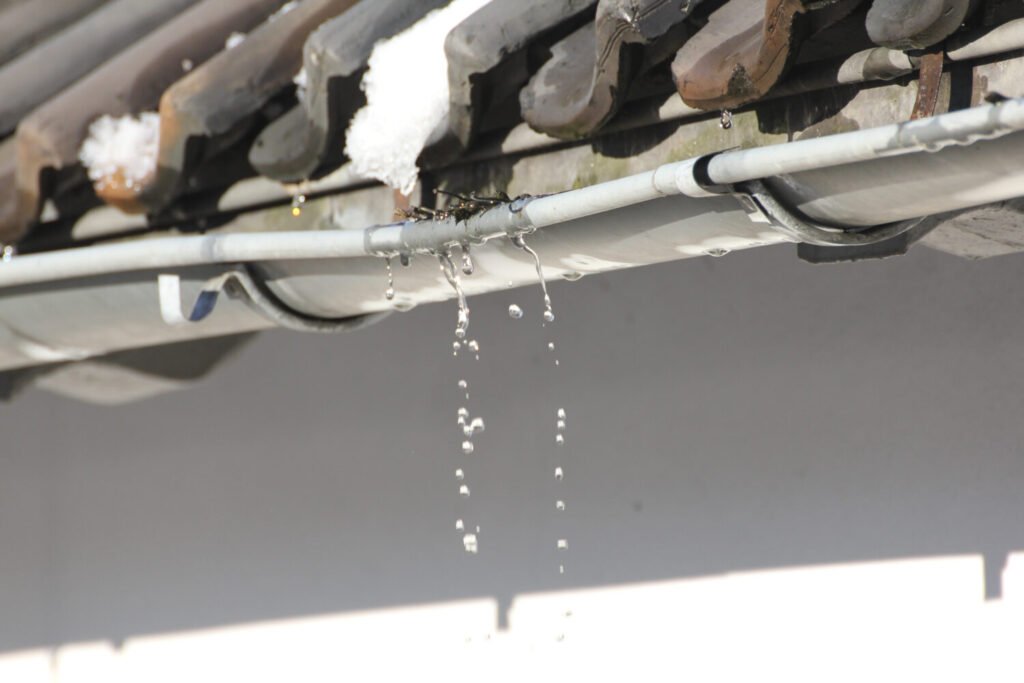
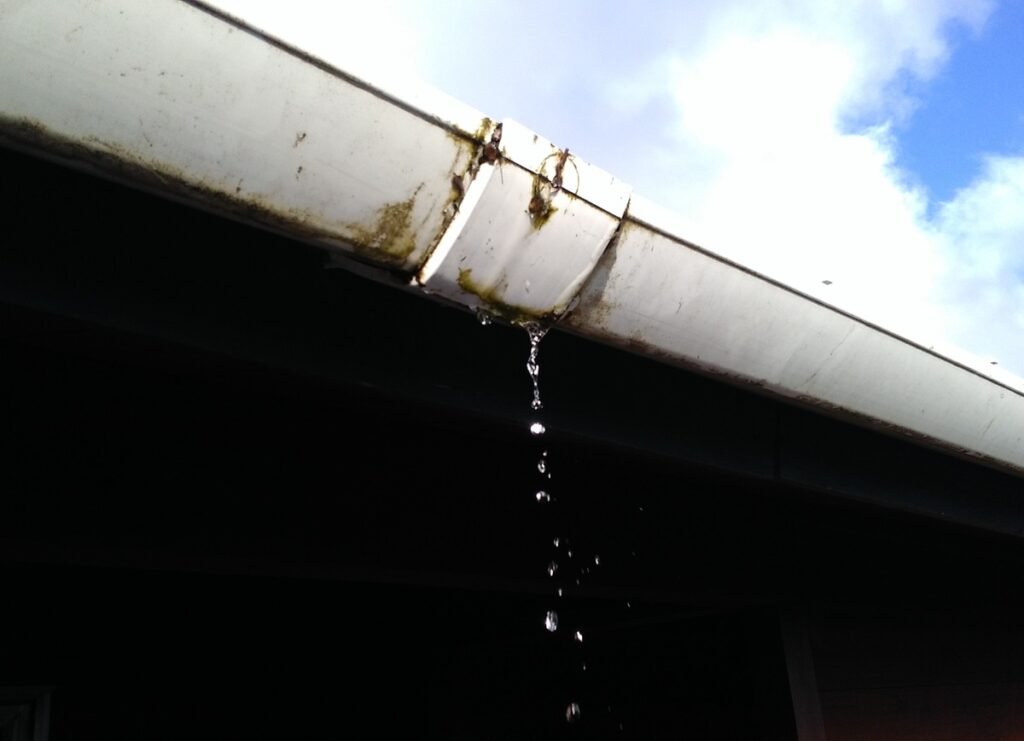
Catching a gutter leak early can save you from major headaches and costly repairs down the line. Here’s why it’s so important for Auckland homeowners to act quickly, especially given the city’s challenging weather conditions.
A leaking gutter allows water to seep into areas it shouldn’t, like your foundation, walls, or roofline. In Auckland, where heavy downpours of up to 150mm in a single day are common during winter storms (per NIWA), this can lead to foundation cracks, weakened walls, or even subsidence over time. Foundation repairs in Auckland can cost $10,000-$30,000, depending on the extent of the damage. A client in Titirangi we worked with noticed water pooling near their foundation during a storm—after fixing a leaking gutter, we prevented further damage that could have cost $15,000 to repair.
Auckland’s high humidity (70-80% year-round) creates the perfect environment for mold and mildew to thrive in damp areas caused by gutter leaks. Leaking water can also attract pests like rodents, ants, or cockroaches, which seek out moist environments. Mold remediation in Auckland typically costs $2,000-$5,000, and pest control adds another $200-$500. In Mt Roskill, we helped a homeowner address a leaking gutter that had caused mold growth on their fascia board, saving them from a major health hazard and a $3,500 remediation bill.
Ignoring a leaking gutter can lead to cascading issues, from rotted fascia boards to damaged roofing or even interior water damage. The cost of fixing a small leak might be $150-$300, but repairing foundation damage or replacing a roof can run into the tens of thousands. Early detection and repair are far more cost-effective, especially in Auckland’s wet climate, where water damage can escalate quickly. A client in West Harbour we assisted caught a leak early, spending just $200 on repairs instead of the $8,000 it would have cost to fix their damaged foundation.
A well-maintained gutter system enhances your home’s value by protecting its structural integrity. According to a 2023 report by Barfoot & Thompson, homes in Auckland with visible water damage can lose up to 10% of their market value—potentially $50,000-$100,000 for an average property. By addressing gutter leaks early, you ensure your home remains a valuable asset. In Albany, we helped a client fix a leaking gutter before selling their home, boosting their sale price by $40,000 by avoiding visible water damage.
Knowing how to tell if your gutter is leaking starts with recognizing the warning signs. Here are the most common indicators to watch for in your Auckland home, especially during the rainy season from May to August.
If you notice puddles or soggy ground near your home’s foundation during or after rain, your gutter might be leaking. Gutters should direct water away from your foundation via downspouts, so pooling suggests a leak, blockage, or poor slope. In Auckland’s clay-heavy soils, like those in Papakura, this can lead to soil expansion and foundation movement. A client in Papakura we worked with found water pooling after a storm—we traced it to a cracked gutter section and fixed it before foundation damage occurred, saving them $12,000 in potential repairs.
Fascia boards, the timber or metal boards behind your gutters, can show signs of water damage if your gutter is leaking. Look for discoloration, stains, or rot, which indicate water is escaping and soaking the fascia. In Auckland’s wet climate, untreated timber fascias rot quickly, often within 1-2 years of exposure. We repaired a rotted fascia board for a client in Mt Eden, caused by a leaking gutter joint, preventing further structural damage and a $2,000 replacement cost.
Peeling paint or rust marks on your home’s exterior near the gutters are telltale signs of a leak. Water escaping from the gutter can cause paint to bubble or peel, and metal gutters may show rust spots, especially in coastal areas like West Harbour, where salt air accelerates corrosion. A client in Albany we helped noticed peeling paint under their eaves—after inspecting, we found a small hole in the gutter that was leaking during rain, which we sealed for $150.
If your gutter is sagging or pulling away from the fascia board, it may be due to a leak that’s caused structural stress. Leaks often lead to water buildup, adding weight and pulling the gutter away from its brackets. In high-wind zones like Orakei (wind speeds up to 44m/s, per NZS 3604), this can worsen quickly, especially during storms. We fixed a sagging gutter for a client in Orakei, reinforcing the brackets and sealing the leak to restore stability, preventing a $1,500 replacement.
Inspect your gutters for visible cracks, holes, or splits, especially at joints or seams. These are common in older Auckland homes with aluminum or PVC gutters that have weathered over time, particularly after exposure to UV rays and heavy rain. Small cracks can often be sealed, but larger holes may require replacement. In West Harbour, we found a client’s gutter had a 5cm hole causing leaks—we sealed it with waterproof sealant, saving them from a $2,000 full replacement.
If water is spilling over the sides of your gutter during rain, it could indicate a leak, blockage, or poor slope. In treed areas like the Waitakere Ranges, debris buildup from pohutukawa or pine trees often causes overflow, which can mask a leak. A client in Albany we worked with thought their overflow was due to leaves, but we found a leaking seam that was exacerbating the issue—fixing it stopped the overflow and protected their home from water damage.
If you notice mold, mildew, or moss growing on your exterior walls near the gutters, it’s a sign that water is leaking and creating a damp environment. Auckland’s humid climate (70-80% year-round) makes this a common issue, especially in shaded areas. In Mt Roskill, we helped a client remove mold from their exterior wall caused by a leaking gutter, then repaired the gutter to prevent further growth, saving them $1,500 in remediation costs.
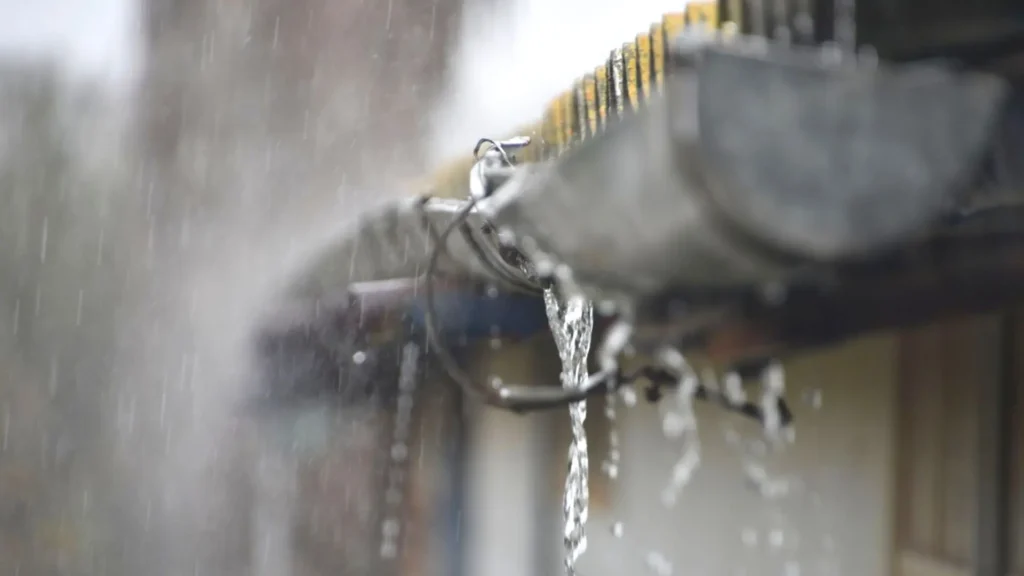
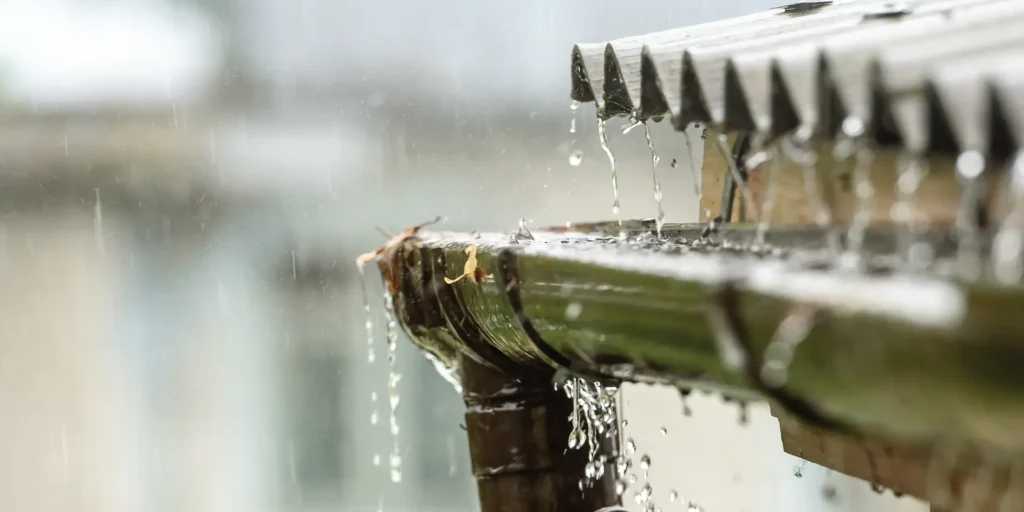
Auckland’s unique climate, geography, and environmental factors present specific challenges when it comes to gutter leaks. Here’s a deeper look at these issues and how they impact your home.
Auckland’s annual rainfall of 1,200mm, with heavy downpours of up to 150mm in a single day during winter storms, puts immense pressure on gutter systems. If your gutters are leaking, this volume of water can quickly overwhelm your home’s drainage, leading to pooling, foundation damage, or erosion. In Titirangi, we helped a client whose leaking gutter couldn’t handle a heavy storm, causing water to pool and erode their garden—we fixed the leak and added a downspout extension to improve drainage.
Auckland’s coastal suburbs, like Orakei, Takapuna, and West Harbour, experience high winds (up to 44m/s, per NZS 3604), which can loosen gutter brackets or cause debris to damage gutters, leading to leaks. Salt air in these areas also accelerates rust in metal gutters, increasing the risk of cracks and holes. In Orakei, we repaired a client’s gutter that had been loosened by high winds, sealing a leak and reinforcing the brackets to withstand future storms.
Many Auckland areas, like Papakura, Henderson, and the North Shore, have clay-heavy soils that expand when wet and contract when dry, causing the ground to shift. A leaking gutter that directs water to the foundation can exacerbate this movement, leading to cracks or subsidence. Foundation repairs in these areas can cost $10,000-$30,000. In Papakura, we fixed a client’s leaking gutter that was causing soil expansion near their foundation, preventing a $20,000 repair bill.
Auckland’s treed suburbs, such as the Waitakere Ranges, Titirangi, and Mt Eden, are prone to debris buildup from leaves, twigs, and seeds, especially from native trees like pohutukawa and kauri. This debris can block gutters, causing water to back up and leak at seams or joints. Regular cleaning is essential to prevent this issue. In the Waitakere Ranges, we cleared a client’s gutters of debris and fixed a leaking seam, ensuring water flowed freely and protecting their home.
Now that you know the signs and challenges, here’s how to tell if your gutter is leaking with a hands-on inspection. These steps are simple enough for any Auckland homeowner, property manager, or DIY enthusiast to follow.
The best time to check for leaks is during or right after rain, when water is actively flowing through your gutters:
If it’s not raining, you can simulate rainfall with a hose to check for leaks:
Blockages in downspouts can cause water to back up and leak from the gutter, a common issue in Auckland’s treed suburbs:
Some leaks are hard to spot from the ground, so inspect your gutters from underneath for a closer look:
Debris buildup can cause water to back up and leak, even if there’s no structural damage:
Safety Note: Always use a stable ladder and have someone spot you while working at height. In Auckland’s high-wind zones (up to 44m/s), avoid inspecting on windy days to reduce the risk of ladder accidents. Wear gloves to protect your hands from sharp edges or debris, and use safety glasses to shield your eyes from falling debris.
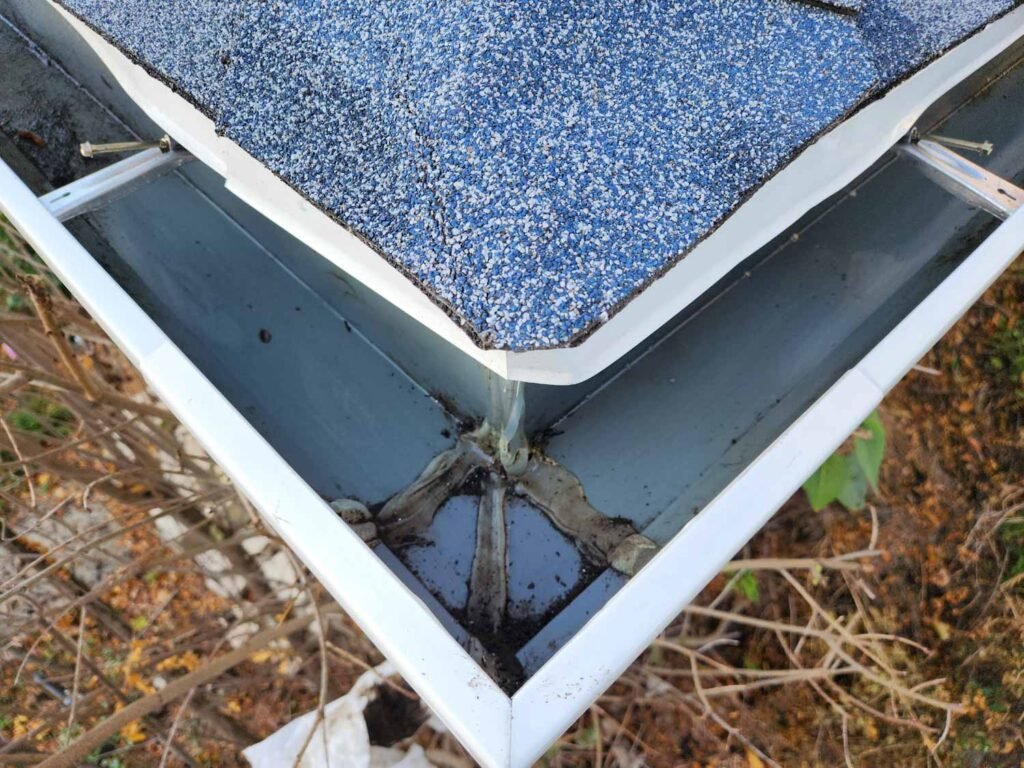
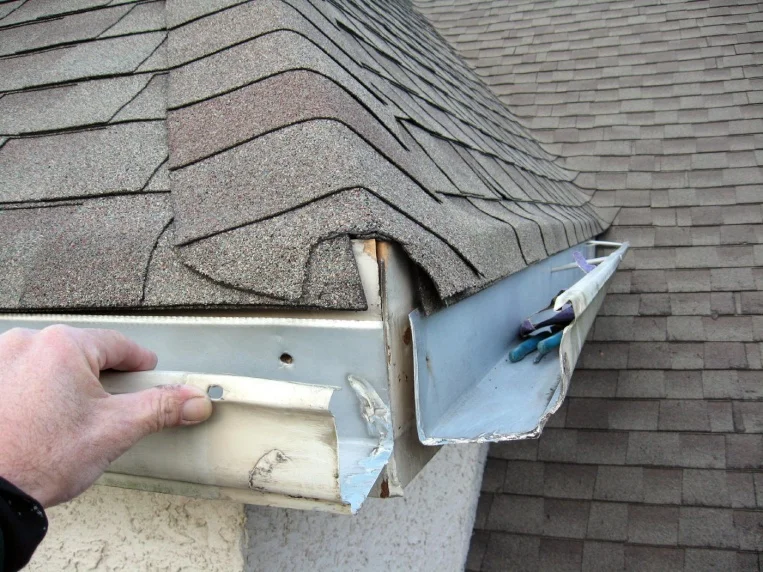
Preventing gutter leaks is often easier and more cost-effective than repairing them. Here are some preventative maintenance tips tailored for Auckland homeowners to keep your gutters in top shape.
Clean your gutters at least twice a year—once in autumn (April-May) and once in spring (September-October)—to remove debris like leaves, twigs, and moss. In treed areas like Titirangi or the Waitakere Ranges, you may need to clean quarterly. Use a ladder, gloves, and a trowel to scoop out debris, then flush the gutter with a hose to ensure water flows freely. In Albany, we helped a client set up a bi-annual cleaning schedule, reducing their risk of leaks by 80%.
Gutter guards (or leaf guards) can prevent debris buildup, reducing the risk of blockages and leaks. They’re especially useful in Auckland’s treed suburbs, where falling leaves are a constant issue. Gutter guards cost $10-$20 per meter installed (available at Bunnings or Mitre 10). In Mt Eden, we installed gutter guards for a client, cutting their cleaning frequency in half and preventing overflow-related leaks.
Loose or damaged brackets can cause gutters to sag, leading to poor water flow and leaks. Inspect your brackets annually and tighten or replace any that are loose or rusted. Stainless steel brackets ($5-$10 each) are best for Auckland’s humid and coastal conditions. In Orakei, we replaced a client’s rusted brackets with stainless steel ones, preventing sagging and leaks during high winds.
Apply a waterproof sealant like Sika Sikaflex ($15 at Bunnings) to gutter joints and seams every year to prevent leaks. This is especially important for older gutters that may have worn seals. In West Harbour, a client we advised sealed their gutter joints annually, extending the life of their system by 5 years and avoiding costly repairs.
Auckland’s storms, especially in winter, can damage gutters with high winds or heavy rain. After a storm, inspect your gutters for cracks, loose brackets, or debris buildup. In Titirangi, we helped a client inspect their gutters after a July storm, finding a small crack that we sealed before it caused a major leak.
Once you’ve confirmed your gutter is leaking, you’ll need to decide whether to fix it yourself or call a professional. Here’s how to weigh your options, along with the risks of ignoring the issue.
Small leaks, like minor cracks or holes, can often be fixed with a DIY approach:
Larger or more complex leaks often require professional expertise to ensure a lasting fix:
Ignoring a leaking gutter can lead to serious consequences, especially in Auckland’s wet and humid climate:
While some leaks can be fixed with a DIY approach, certain situations require professional help to ensure a long-lasting solution. Here’s when to call the experts at My Homes Construct Ltd.
If your gutter keeps leaking despite DIY repairs, there may be an underlying issue, such as poor installation, improper slope, or extensive damage. A professional can diagnose and fix the root cause, ensuring your gutter system works effectively. In St Heliers, we helped a client with recurring leaks by adjusting their gutter slope and replacing damaged sections, stopping the issue for good and saving them $2,500 in future repairs.
Sagging, detached, or severely cracked gutters often indicate structural damage that requires professional repair or replacement. In high-wind areas like Orakei, this can happen quickly if not addressed, especially during storm season. We fixed a detached gutter for a client in Orakei, reinforcing it with stainless steel brackets to withstand Auckland’s windy conditions, costing $400 but preventing a $3,000 replacement.
If your gutter leak has caused damage to the fascia board or soffit (the underside of your roofline), a professional can repair or replace these components to prevent further issues, such as roof leaks or pest entry. In West Harbour, we replaced a client’s rotted fascia board and fixed their leaking gutter, ensuring their roofline was protected from further water damage, for a total cost of $600.
In coastal areas like West Harbour or Takapuna, salt air can cause metal gutters to rust quickly, leading to leaks. If rust is widespread, a professional can replace the affected sections with corrosion-resistant materials like Colorsteel or PVC. In Takapuna, we replaced a client’s rusted aluminum gutter with Colorsteel, preventing leaks and extending the system’s life by 15 years.
Here are two real-world examples of gutter leak repairs we’ve completed at My Homes Construct Ltd, showcasing how early detection and professional expertise can save Auckland homeowners from costly damage.
A homeowner in Titirangi noticed water pooling near their foundation during a heavy July storm. Using the hose test method we recommended, they identified a leaking seam in their gutter. We inspected the system, sealed the seam with Sika Sikaflex, and added a downspout extension to direct water further from the foundation. The repair cost $250, but it prevented an estimated $15,000 in foundation damage, given Titirangi’s clay-heavy soil and steep terrain, which exacerbate drainage issues.
A client in Orakei, a high-wind zone, contacted us after noticing their gutter was sagging and leaking during a storm. High winds (up to 44m/s) had loosened the brackets, and salt air had caused rust, leading to a 3cm hole. We replaced the rusted section with Colorsteel, reinforced the brackets with stainless steel, and sealed all joints. The project cost $500, but it saved the client from a $3,500 gutter replacement and protected their fascia board from further water damage.
Selecting the right gutter materials can prevent leaks and extend the life of your system in Auckland’s challenging conditions. Here are expert tips from My Homes Construct Ltd.
In coastal areas like West Harbour, Takapuna, or Mission Bay, choose corrosion-resistant materials like Colorsteel, PVC, or stainless steel to prevent rust caused by salt air. Colorsteel gutters, for example, come with a 15-year warranty and cost $20-$30 per meter installed. In West Harbour, we installed Colorsteel gutters for a client, eliminating rust-related leaks for over a decade.
Seamless gutters, which are made from a single piece of material, have fewer joints and seams, reducing the risk of leaks. They’re more expensive ($25-$35 per meter) but worth it in Auckland’s wet climate. In Mt Eden, we installed seamless Colorsteel gutters for a client, cutting their maintenance needs by 50% and eliminating seam leaks.
For metal gutters, opt for a powder-coated or galvanized finish to protect against rust and UV damage. PVC gutters should have UV stabilizers to prevent cracking in Auckland’s sunny summers (UV index up to 12 in January). In Albany, we replaced a client’s cracked PVC gutter with a UV-stabilized version, ensuring it lasted 20 years without leaks.
Auckland’s high rainfall requires gutters with adequate capacity. For most homes, a 125mm-150mm wide gutter is sufficient to handle heavy downpours. In Titirangi, we upgraded a client’s undersized gutters to 150mm Colorsteel, preventing overflow and leaks during winter storms.
Here are answers to more frequently asked questions, formatted for voice search and NLP optimization.
Look for signs like water pooling around your foundation, stained fascia boards, peeling paint, sagging gutters, visible cracks, overflow during rain, or mold on exterior walls. Inspect during a rainstorm or use a hose test to confirm.
Ignoring a leaking gutter can lead to foundation damage, mold growth, pest infestations, and costly repairs ($5,000-$20,000). In Auckland’s wet climate, these issues can escalate quickly, potentially reducing your home’s value by 10%.
Yes, for small cracks or holes, you can use a waterproof sealant like Sika Sikaflex. For larger leaks, structural damage, or fascia issues, call a professional to ensure a lasting fix and avoid further damage.
Inspect your gutters at least twice a year—in autumn (April-May) and spring (September-October)—and after major storms. In treed areas like the Waitakere Ranges, inspect quarterly to prevent debris-related leaks.
Colorsteel, PVC, or stainless steel are ideal for Auckland’s wet and humid climate, especially in coastal areas. Seamless gutters with a 125mm-150mm width are best for handling heavy rainfall and reducing leaks.
Knowing how to tell if your gutter is leaking can save you from costly repairs and protect your Auckland home from water damage. By recognizing the signs—like water pooling, stained fascia, or overflowing gutters—performing a quick leak check, and following preventative maintenance tips, you can address issues early. While small leaks might be a DIY fix, larger problems, recurring leaks, or structural damage require professional expertise to prevent foundation issues, mold growth, and other costly problems in Auckland’s wet and windy climate.
Don’t ignore a leaking gutter—protect your Auckland home today!
📞 Call My Homes Construct Ltd at +64 22 315 8987
📍 Visit us at 84B West Harbour Drive, West Harbour, Auckland 0618
We offer expert gutter inspections, repairs, and leak prevention tailored to New Zealand’s unique weather conditions—let’s keep your home safe and dry!
WhatsApp us